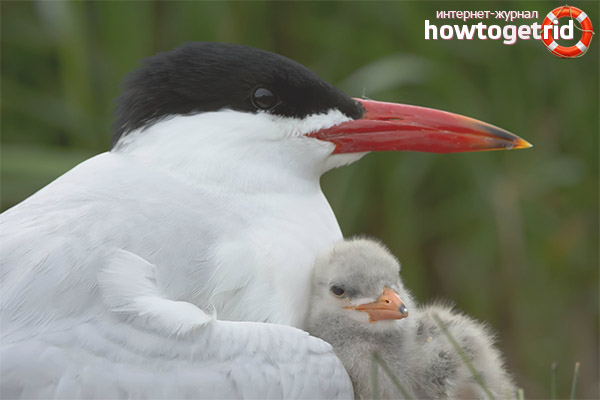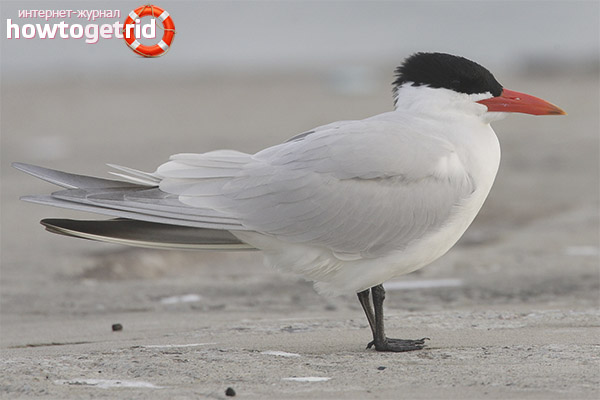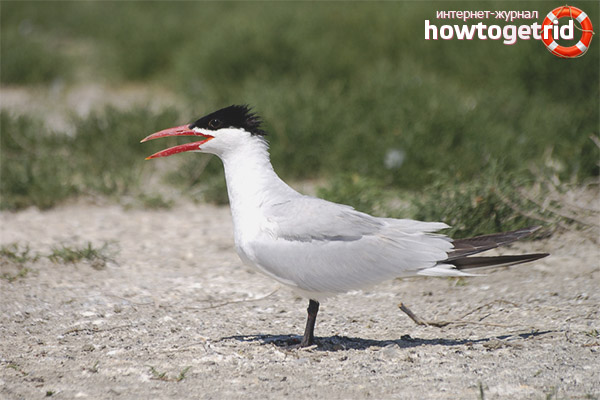The content of the article
This species of terns, like tegrava, is the largest of the family of these birds, only slightly inferior in size to a silver gull. Chegrava differs from this species of birds with a characteristic hat that has a rich dark color, of the same color with its paws, a bright red beak and a tail ending in a neckline.
It rises into the air mainly for food, flies easily, its beak, like most terns, is lowered down. For fishing, it is immersed in water from the fly. Cegrava has a peculiar low voice, makes loud, grating or short sounds. The preferred resting place for this bird is the shore of a pond.
The average life expectancy of waterfowl in their natural habitat is about 7-8 years.
Natural habitat
Although the nesting area of birds of this species is quite extensive, nevertheless, within it, the distribution of the species is sporadic. Prefers moderate latitudes of Europe, Baltic, Caspian Sea, Black Sea, African continent. Also, the habitat is Asia, southwest Siberia, North America, Australia, New Zealand. The wintering area is South Africa, mainly the coastal zone, India, southeast China, the Mediterranean.
Preferred areas for birds to live are the pebble and sandy coasts of water bodies (seas, lakes, rivers), rocky areas. Typically, such habitats are selected for nesting. Note that when choosing a place, transparency of water is of particular importance for this type of bird.
Outside the nesting period, the redgrass is mainly kept near the seas, as well as near large reservoirs with a small current. As a rule, chegraws do not form large colonies, keep in small groups.
Dimensions and structure
Power Features
It mainly feeds on small fish and invertebrates. The main difference between this species and ordinary terns is that sometimes cegrava can eat eggs and chicks of other birds.
During the hunt for fish, the bird flies, rises into the air above the water surface to a small height, having seen its prey, makes a sharp stop, and then rushes down, while submerging not only its sufficiently long beak, but also its head.
During the nesting period, such fodder departures of the chegrave are carried out over short distances. For catching prey, the bird selects exclusively reservoirs with clear and clear water.
Reproduction of the species

Chegraws are monogamous. The maturity of birds of this bird species occurs when 3 years are reached. In addition to pairs of birds, single individuals are also found in the nests of colonies. Pairs are created after the birds arrive at the nesting site.
One colony of birds can number from 100 to 200 nests, usually isolated from each other. In colonial nests, the bird behaves very noisily.
Directly, the nest of Chegrava itself is a small depression in the ground (sand, shell rock). Note that often in such nests there is no litter; if there is one, then small fish bones and stalks of dry plants are used as material for it.
The average number of eggs in a clutch is 2-3.When hatching eggs, birds (both females and males) are quite careful and shy. The color of the eggshell varies from a pale greenish tint to brownish. In this case, the eggs are covered with dark spots, condensing to the base.
Often the clutch and the newly emerged offspring of Chegrave die as a result of attacks by more ravenous birds, including gulls. If the clutch is destroyed, the bird is carried repeatedly, but in this case the number of laid eggs does not exceed 1-2 pcs.
Both parents take part in the brooding process, as a rule, the duration is about three weeks. Young offspring at the age of one and a half months takes to the wing and is ready for independent flights.
Features of molting chegrava
Shedding of this species of birds has its own sequence: the first along with include - chick-down, winter and mating. To the second: winter and marriage. In fact, the first mating order of a bird is basic. Like most species of terns, the adult Cegrava molt twice a year: before the mating season in spring and after the mating season in autumn.
- A partial change in the plumage of young Chegrava chicks, as well as a molting period, which implies a change to the first winter outfit, lasts from the beginning of autumn until January.
- The pre-nuptial plumage of adult plumage lasts from January to March.
- Postnuptial - from mid-summer to November.
Note that deviations from the above dates of the beginning and end of molting of birds are possible, which is caused by disturbances in the normal course of the sexual cycle of individuals. As a rule, molting is delayed in those representatives of the species who were forced to re-lay eggs due to the death of the offspring.
Bird color
- Downy outfit of chicks. The back of the body of a young individual has a grayish-ocher color, in some cases with characteristic brown marks. The neck is gray, the chick’s belly is white with a slight ocher color. The color of the beak is pale red; the top is decorated with a dark spot.
- The mating attire of adults. Almost the entire head of the bird is dark in color, while the occipital feathers stand out a little due to its length, due to which a peculiar crest is formed. Almost the entire back of the bird is pale silver in color, the neck (its back), and the tail are white. Also silver-gray and basic feathers. The beak of an adult Chegrava is bright red, the iris is dark brown, the legs are black.
- The winter outfit of adult birds differs in that the black cap on the head characteristic of this species becomes white with longitudinal marks scattered across it. On the ears and before the eyes of the bird there are small spots of dark color. For the rest, this outfit fully coincides with the marriage.
- Nesting outfit of young birds. The top of the heads of individuals of white color with a characteristic longitudinal pattern, more pronounced than that of adult birds in winter attire. Black spots are also present under the eyes and near the ears. The neck is white-gray with slight dark strokes. The lower back is dark gray, decorated with a border of feathers of brown color. Beak of an orange bird, paws black.
- The first winter outfit that appears after partial molting is similar to the plumage that adult birds get with the main winter outfit. The only difference in this case is that almost all the fly and tail feathers remain from the nesting outfit of young birds. Also, the general gray tone of the color of the back becomes darker, and the plumage of the head has more dark strokes.
- Changing the plumage of the chegrave after the first full molt to the first mating dress implies that some birds get a darker color of plumage on their back.
Video: Chegrava (Hydroprogne caspia)











Submit